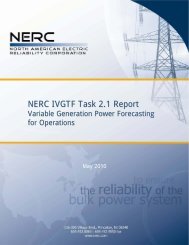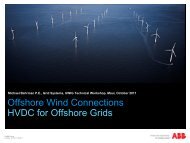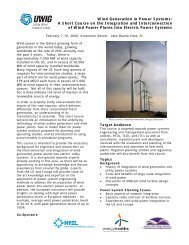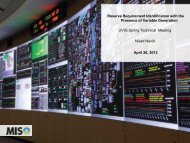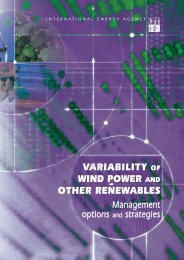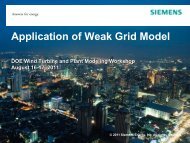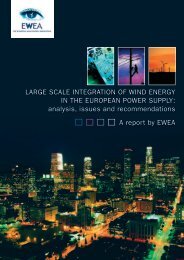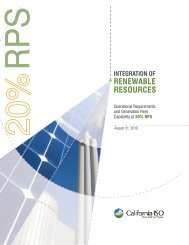Integrating Southwest Power Pool Wind to Southeast Electricity ...
Integrating Southwest Power Pool Wind to Southeast Electricity ...
Integrating Southwest Power Pool Wind to Southeast Electricity ...
Create successful ePaper yourself
Turn your PDF publications into a flip-book with our unique Google optimized e-Paper software.
espectively. Conversely, however, the number of starts on the SPP and SBA CC units decreases<br />
by 22 and 3, respectively. The only place where there is a significant decrease in average<br />
number of starts when wind is added is for CC units in SPP, likely as units are left online <strong>to</strong><br />
provide reserve. The average number of starts for each coal unit increase slightly with the<br />
additional wind for SBA (3), TVA (3), and SPP (1). Although the numbers are small (1-3<br />
additional starts per year per unit), they could be significant as many of these units are not likely<br />
designed <strong>to</strong> cycle.<br />
Table 5-13: Change in starts vs. Scenario 1<br />
Region<br />
Type<br />
Scenario 1<br />
starts<br />
14 GW Scenario 2 Scenario 3 Scenario 4<br />
Scenario 1<br />
Proxy<br />
EES CC 117 -25 -12 -2 9 -1<br />
SOCO CC 204 3 -7 -9 -45 -6<br />
Steam Coal 15 -3 0 2 12 1<br />
TVA CC 240 -16 -37 -53 -11 -9<br />
Steam Coal 7 -3 -1 1 1 0<br />
SPP CC 84 22 103 99 88 109<br />
Steam Coal 8 -1 0 -1 -1 -1<br />
Comparing Scenario 2 <strong>to</strong> scenario 1, it can be seen that there is a reduction in starts for CCs in<br />
each of the three SERC BAs when they are required <strong>to</strong> carry reserve <strong>to</strong> cover the intra-hour<br />
variability of their wind allotment. As a result, the CCs are required <strong>to</strong> remain on line more often<br />
<strong>to</strong> ensure sufficient reserve exists. Conversely, the CCs in SPP cycle more frequently as they no<br />
longer have <strong>to</strong> maintain all reserves for the wind and the CCs correspondingly can be turned off<br />
more frequently in SPP. This increase is not as significant in Scenarios 3 and 4 as the SPP CC<br />
units are utilized more in these shared balancing scenarios due <strong>to</strong> the relative economics of these<br />
units as modeled. On the other hand, TVA shows a larger decrease in CC starts in Scenario 3 and<br />
SBA in Scenario 4, as these units are being turned off for longer periods of time when the less<br />
expensive CCs in SPP and Entergy can be used <strong>to</strong> support the “shared” reserve requirement.<br />
(Although noted previously, it should be noted again that the relative economics of the units in<br />
different regions result from the input data utilized in the UPLAN model and may likely differ in<br />
actual implementation in the future.) In Entergy, Scenario 4 shows an increase in CC starts<br />
compared <strong>to</strong> other scenarios; this is also true for coal in SBA; no hurdle rates means the coal is<br />
started more often <strong>to</strong> provide energy.<br />
More detailed analysis of start-ups for individual CC units is presented in Appendix B.<br />
5-30




